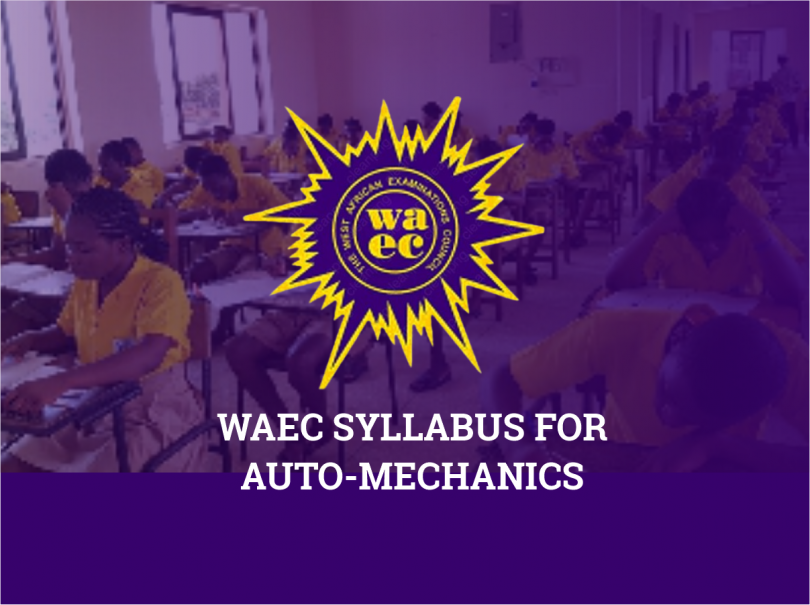This guide welcomes candidates to the WAEC Auto-Mechanics syllabus. It clearly outlines all the topics, from engine basics to vehicle systems and essential safety practices, that you need to study and understand for your examination. Getting familiar with the WAEC Syllabus for Auto-Mechanics is the first step to structuring your learning effectively and confidently preparing for success in your Auto-Mechanics assessment.
The WAEC Syllabus for Auto-Mechanics is structured logically, often divided into major sections or themes that cover the breadth of modern auto mechanics. Within each section, you will find specific learning objectives. These objectives are crucial they explicitly state the competencies you should demonstrate.
WAEC Syllabus For Auto-Mechanics
We bring you the comprehensive WAEC syllabus for Auto-Mechanics. Read it carefully and get familiar with the topics, as the examination questions will be set on each topic.
| S/N | Topic | Subtopics |
|---|---|---|
| 1 | Workshop Safety and Regulations | – Definition of safety and regulations – Causes of workshop accidents – Accident prevention techniques and safety devices (e.g., sand buckets, fire extinguishers) |
| 2 | Tools and Equipment | – Types and uses of tools (marking, measuring, holding, and cutting tools) – Types and uses of equipment (e.g., hand valve, grinding tools) – Maintenance of tools and equipment |
| 3 | Vehicle Layout | – Types of motor vehicle chassis – Principal components, identification, and functions (engine, transmission system, chassis, etc.) – Chassis maintenance |
| 4 | Automobile Engine | – Types of engine designs – Identification of the main components of an engine – Line diagram of a multi-cylinder engine – Types of cylinder liners – Two-stroke and four-stroke cycles (spark ignition and compression ignition engines) – Advantages of a four-stroke cycle over a two-stroke cycle – Engine maintenance and servicing |
| 5 | Transmission System | – Transmission system layout – Types of drives – Components of transmission systems (clutches, gearboxes, etc.) – Operation of a simple plate clutch – Types and operation of gearboxes – Introduction to automatic transmission systems – Conventional layout of the transmission system |
| 6 | Suspension System | – Types and functions of suspension systems – Fault finding, maintenance, and repair of suspension systems |
| 7 | Steering System | – Components and functions of the steering system – Types of steering gearboxes – Manual steering faults and repairs – Operation of power-assisted steering – Steering geometry |
| 8 | Engine Lubrication System | – Purpose and types of lubrication systems – Friction and its disadvantages – Component parts of the lubrication system – Quality and viscosity of lubricants – Oil additives and their importance |
| 9 | Cooling System | – Functions and types of cooling systems – Components of water and air cooling systems – Comparison of air and water cooling systems |
| 10 | Fuels and Combustion | – Fuel component system – General layout and working principle of the fuel supply system – Component parts and functions of the fuel supply system – Types of carburetors, fuel pumps, and their maintenance – Types and properties of fuels – Comparison of mechanical and electrical fuel pumps |
| 11 | Manifold and Air Cleaner | – Types, functions, and maintenance of: – Manifold – Air cleaner – Muffler |
| 12 | Braking System | – Concept of friction, operating principles, and types of braking systems – Faults and maintenance of mechanical and hydraulically operated braking systems – Functions, advantages, and disadvantages of the Anti-lock Braking System (A.B.S) – Layout of the braking system |
| 13 | Wheels and Tyres | – Types and functions of rims and tyres – Vulcanizing – Stating regulations for tire interchange and pressure – Road wheel alignment and balancing |
| 14 | Workshop Management and Enterprise | – Basic concepts of: – Management – Planning – Controlling – Staffing – Directing – Managing resources – Concept of authority and responsibilities in the enterprise – Types of enterprises |
WAEC Auto-Mechanics Examination Structure
The WAEC Auto Mechanics examination assesses candidates’ theoretical knowledge and practical skills in automobile systems. The examination comprises three papers:
Paper 1: Objective Test
- Duration: 45 minutes
- Content: 40 multiple-choice questions covering various topics in auto mechanics.
- Marks: 40 marks
Paper 2: Theory
- Duration: 2 hours 15 minutes
Sections:
- Section A: 10 short-structured questions to be answered in 30 minutes (20 marks).
- Section B: 5 essay questions, with candidates required to answer any four in 1 hour 45 minutes (60 marks).
- Total Marks: 80 marks
Paper 3: Practical Test
- Duration: 2 hours 30 minutes
- Content: Two compulsory practical questions assessing hands-on skills in areas such as fault diagnosis, routine maintenance, and minor repairs.
- Marks: 80 marks
In cases where conducting the practical test is not feasible, an alternative theoretical test may be administered, consisting of two compulsory questions to be answered in 1½ hours for 80 marks.
Recommended Study Materials
To prepare effectively, consider the following resources:
- WAEC Syllabus for Auto Mechanics: Provides detailed topics and objectives.
- Past Question Papers: Familiarize yourself with the exam format and question types.
Textbooks
- Motor Vehicle Technology by J.A. Dolan
- Automotive Mechanics by William H. Crouse and Donald L. Anglin
- Fundamentals of Motor Vehicle Technology by V.A.W. Hillier and Peter Coombes.







Leave a Comment